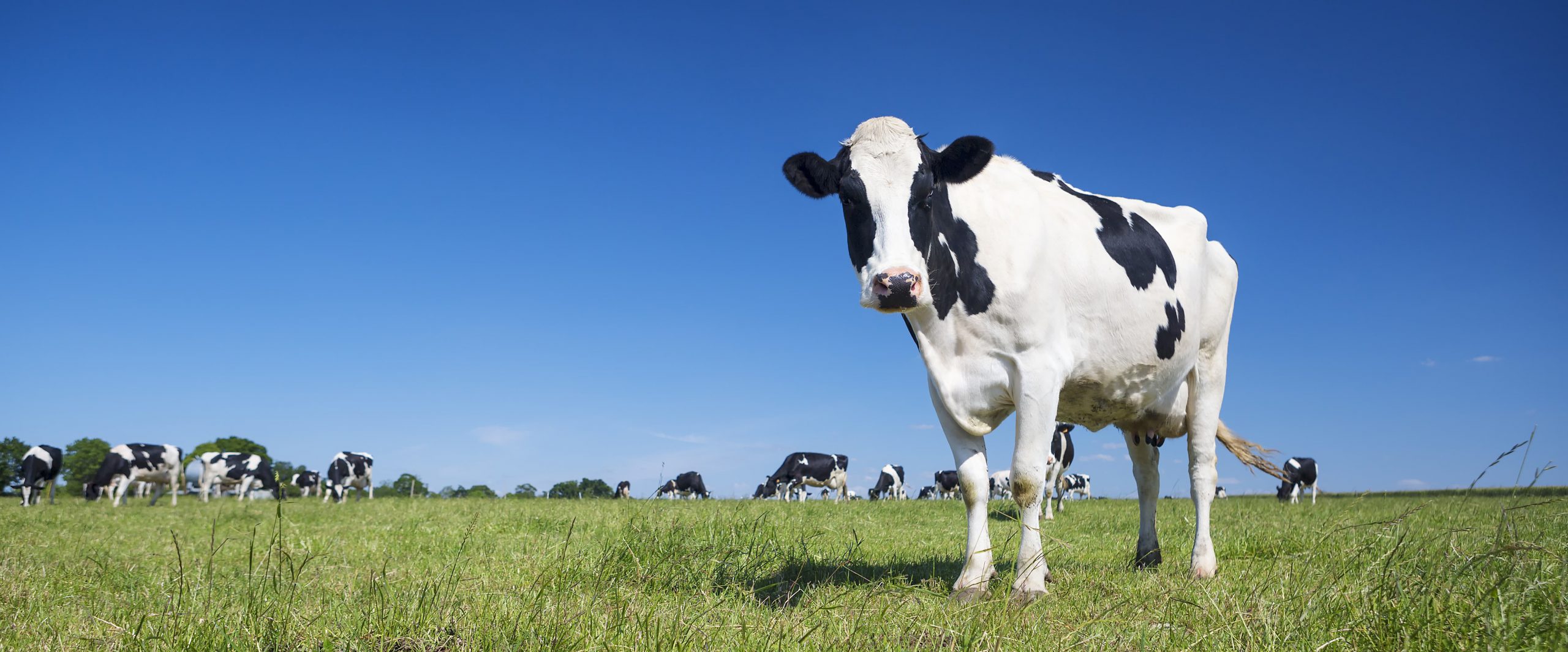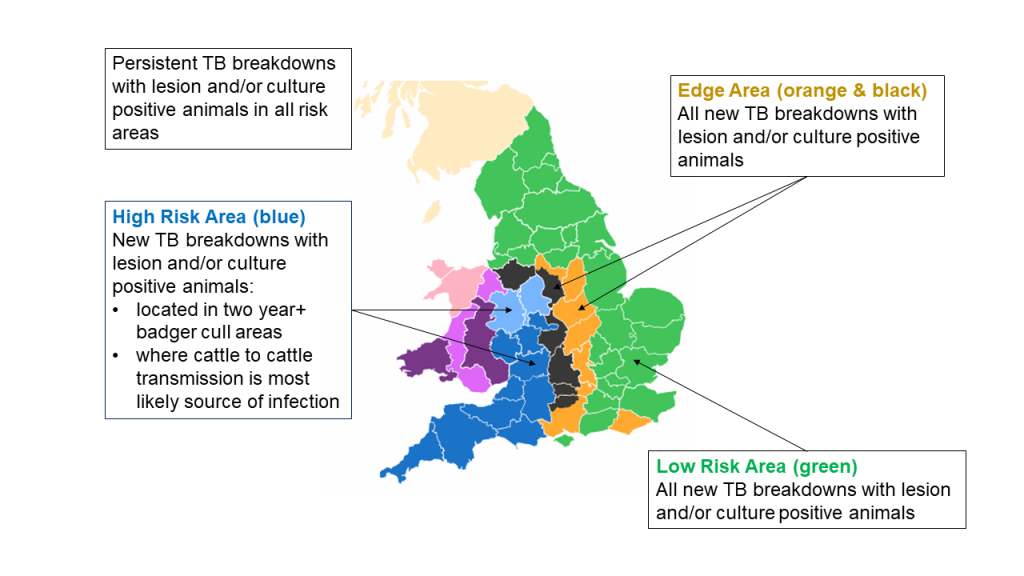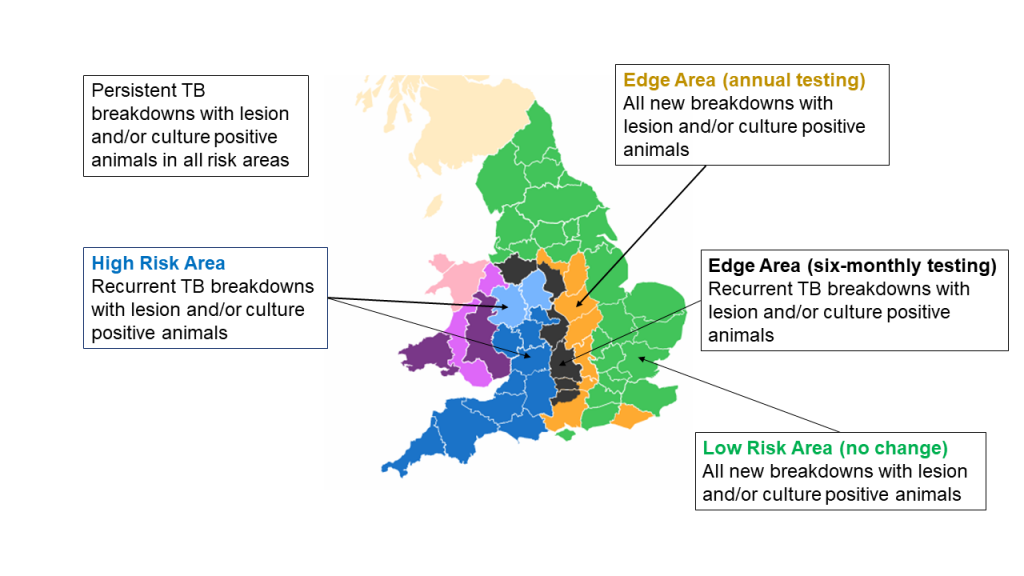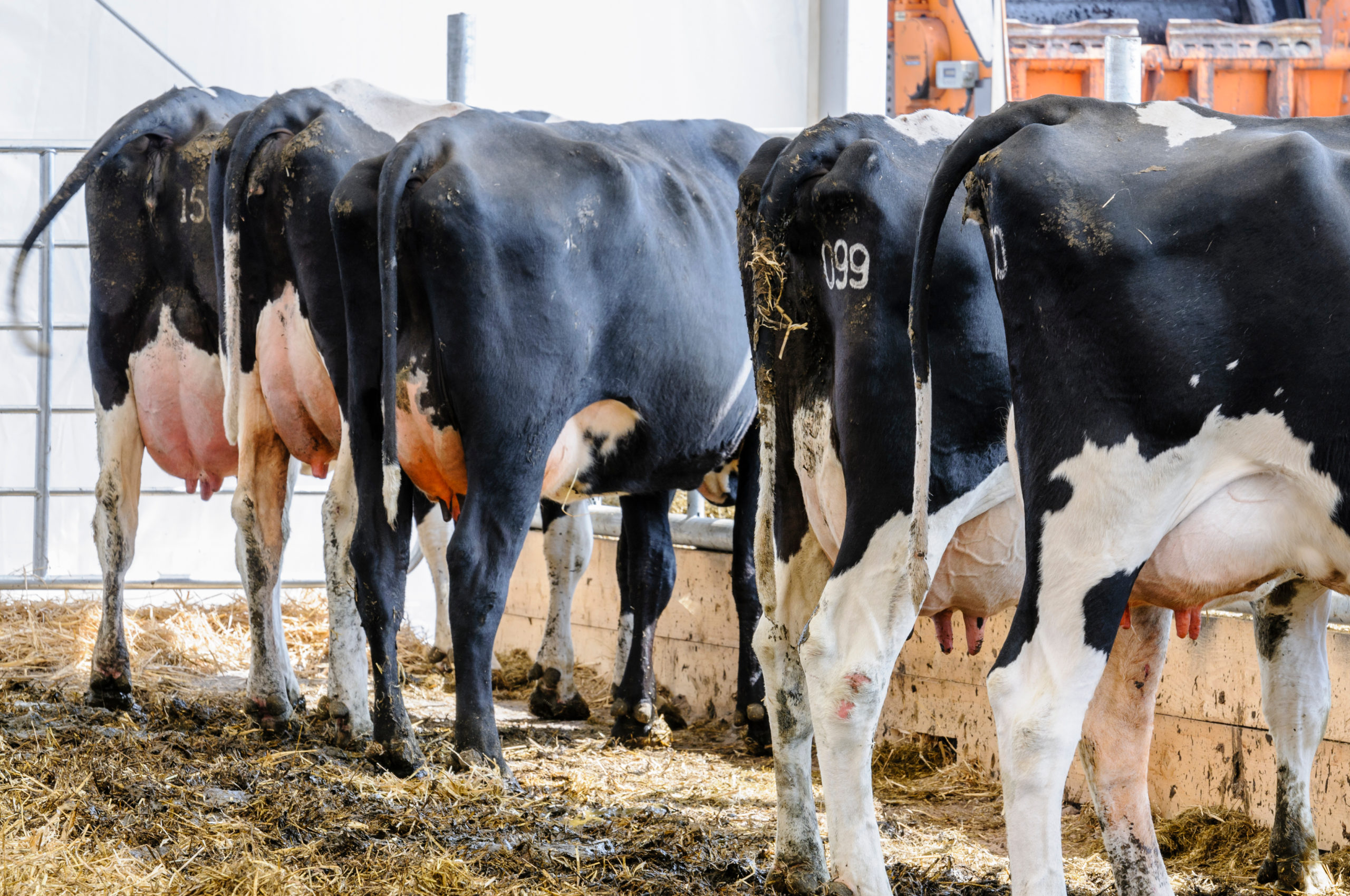In 2017, use of the supplementary interferon-gamma (‘gamma’) test was increased in TB breakdown herds in the High Risk Area (HRA) of England following a public consultation. In 2018, the Godfray review of the government’s strategy for achieving officially TB free (OTF) status for England, highlighted the need to use more sensitive diagnostic methods such as the gamma test, in a more targeted way.
In the government response to the Godfray review published in March 2020, Defra committed to reviewing the gamma testing policy in England and a public consultation was launched in January 2021. As set out in the government response to the consultation, APHA is implementing changes to the current gamma testing policy in the HRA and Edge Area of England.
Background

The gamma test is a supplementary diagnostic test used in specific scenarios to enhance the sensitivity of TB testing. Deploying the gamma test alongside the skin test has the following expected benefits:
- Identifies TB-infected animals at an earlier stage of infection than the skin test, allowing removal before they spread infection to other animals in the herd.
- Identifies TB-infected animals that simply don’t respond to the skin test. This increases the probability of detecting all infected animals in the herd.
- Reduces the likelihood of residual cattle infection in herds after movement restrictions have been lifted at the end of a breakdown, which in turn reduces the likelihood of recurrent breakdowns.
- Reduces the risk of spreading TB to other herds via movements of infected cattle and to local wildlife.
To maximise these potential benefits, APHA deploys the gamma test in eligible TB breakdown herds at the earliest practical opportunity.
Previous gamma testing policy in England
Mandatory testing
From 1 April 2017 to 12 July 2021, the gamma test was applied as a mandatory test alongside the skin test to help resolve TB breakdowns with lesion and/or culture positive animals in the HRA where any of the following three criteria were met.
The APHA veterinary investigation concludes that the most likely bTB transmission route for the affected herd was contact with infected cattle (e.g. via cattle movements, residual cattle infection from a previous TB breakdown, or contact with a contiguous infected herd) and measures are in place to prevent further spread of the disease from this source.
The infected herd is in one of the areas where at least two annual rounds of effective licensed badger culling have been completed.
There is clear evidence that repeat skin testing of the herd has failed to resolve a TB breakdown i.e. chronic and persistent breakdowns. Persistent breakdowns are those where the herd has been under movement restrictions longer than 18 months.
In the Low Risk Area (LRA) and Edge Area, mandatory gamma testing was applied to all new TB breakdowns with lesion and/or culture positive animals, and in persistent breakdown herds. The infographic below summarises the previous gamma testing policy in England.

Discretionary testing
Discretionary gamma testing was, and still is, applied by APHA in certain situations where the TB breakdown is not automatically eligible for mandatory testing, for example in extensive breakdowns with high numbers of reactor animals. Gamma testing is also used by APHA in other ad hoc scenarios such as informing decisions about partial or whole herd slaughter for TB control reasons.
What has changed?
Since 12 July 2021, the gamma testing policy in the HRA and Edge Area of England changed as follows.
HRA
In the HRA, all new TB breakdown herds with lesion and/or culture positive animals are assessed against a criterion for recurrence. If a herd satisfies the following criterion then it will require a mandatory gamma test:
The breakdown occurred within 18 months of the herd regaining officially TB free (OTF) status following a previous breakdown with lesion and/or culture positive animals.
Further detail on assessing the requirement for mandatory gamma testing under this criterion can be found in the Q&A below. For TB breakdown herds that do not meet the above criterion for mandatory testing, APHA can apply discretionary testing following veterinary assessment of the case.
Edge Area
All new TB breakdown herds with lesion and/or culture positive animals in the annual surveillance testing parts of the Edge Area continue to require a mandatory gamma test.
All new TB breakdown herds with lesion and/or culture positive animals in the six-monthly surveillance testing parts of the Edge Area are assessed against the above criterion for recurrence as for herds in the HRA. If a herd satisfies the criterion then it will require a mandatory gamma test.
The policy in the LRA remains unchanged i.e. all new TB breakdowns with lesion and/or culture positive animals require a mandatory gamma test. Persistent breakdown herds (those reaching 18 months under movement restrictions) in England continue to require a mandatory gamma test. Discretionary testing continues to be applied as per the previous policy outlined above. The infographic below summarises the changes to the mandatory gamma testing policy in England.

The following table compares the previous and new policies for mandatory gamma testing in each of the three bTB risk areas in England.
| Mandatory testing | Previous policy | New policy |
|---|---|---|
| High Risk Area | Breakdowns with lesion and/or culture positive animals which met the following criteria: Criterion 1 – herds where the most likely source of infection determined by the APHA investigation was cattle related e.g. cattle movements, contiguous infection, recrudescence. Criterion 2 – herds located in a badger control area that has completed at least two annual rounds of effective licensed badger culling. Criterion 3 – chronic and persistent breakdowns. | New breakdowns with lesion and/or culture positive animals which meet the following criterion: The breakdown occurred within 18 months of the herd regaining OTF status following a previous breakdown with lesion and/or culture positive animals. Chronic and persistent breakdowns with lesion and/or culture positive animals. |
| Edge Area | All new breakdowns with lesion and/or culture positive animals Chronic and persistent breakdowns with lesion and/or culture positive animals. | New breakdowns with lesion and/or culture positive animals in six-monthly surveillance testing parts which meet the following criterion: The breakdown occurred within 18 months of the herd regaining OTF status following a previous breakdown with lesion and/or culture positive animals. All new breakdowns with lesion and/or culture positive animals in annual surveillance testing parts. Chronic and persistent breakdowns with lesion and/or culture positive animals. |
| Low Risk Area | All new breakdowns with lesion and/or culture positive animals. Chronic and persistent breakdowns with lesion and/or culture positive animals. | No change |
Rationale for the policy change
As part of its response to the Godfray review, Defra committed to reviewing the previous gamma testing policy in England, and in particular, the HRA, which had been in place since April 2017.
Shifting the emphasis from new TB breakdown herds in badger culling areas to recurrent breakdowns represents an evolution of the gamma testing policy. The aim is to target infected herds in which the increased sensitivity of the blood test will yield the greatest benefit both individually and in reducing the bTB epidemic as a whole.
Recurrence of infection plays a large part in the bTB epidemic in the HRA, and to a lesser but still significant extent in the Edge Area too. In the HRA in 2019, 56% of new TB incidents occurred in herds that had suffered at least one previous breakdown in the preceding 36 months, and in the Edge Area, the proportion was 46%1. Targeting herds that suffer repeat breakdowns with supplementary blood testing will reduce the likelihood of leaving undetected infected animals in the herd. This also has wider benefits of reducing the risk of the disease being spread to new herds through cattle movements, and to wildlife.
Q&A
The gamma testing policy for TB breakdown herds in the HRA and Edge Area of England has changed. See the table above for full details of exactly what this means for breakdown herds in each bTB risk area.
Defra committed to reviewing the previous gamma testing policy in England as a result of suggestions made in the Godfray review. The changes to the way that gamma testing is deployed in TB breakdown herds represents an evolution of the policy as we make progress towards achieving OTF status for England. The aim is to use the test in herds where the increased sensitivity will yield the greatest benefit in terms of reducing the bTB epidemic.
The new gamma testing policy in the HRA and Edge Area of England came into effect on 12 July 2021. All new TB breakdowns with a confirmation date on or after 12 July 2021 in the HRA and six-monthly testing parts of the Edge Area are assessed against the criterion for recurrence. The confirmation date is the date on which any animals with visible lesions were slaughtered, or in the case of culture positive results, the date that the results were reported by APHA.
All new TB breakdowns with a confirmation date (see previous question) on or after 12 July 2021 are assessed against the following criterion for recurrence: The breakdown occurred within 18 months of the herd regaining OTF status following a previous breakdown with lesion and/or culture positive animals. A previous OTFW breakdown within 18 months of the current OTFW breakdown may not necessarily be the most recent breakdown and therefore all OTFW breakdowns within the 18 month period are assessed against the criterion for recurrence. If less than 18 months has elapsed between day 1 (TT1) of the skin test leading to lifting of restrictions at the end of a previous breakdown and restrictions being applied at the beginning of the current breakdown i.e. day 2 (TT2) of the disclosing skin test or date of slaughterhouse case, then the herd will require a mandatory gamma test. A slaughterhouse case is where typical lesions of TB are found in the carcase of cattle sent for routine private commercial slaughter.
Your herd will only require a mandatory gamma test if it has previously suffered a breakdown within 18 months of confirmation of the current breakdown. See the Q&A above on the criterion used by APHA to assess for recurrence. If there is veterinary justification to do so, APHA may carry out discretionary gamma testing on your herd even if it doesn’t automatically qualify for mandatory testing.
Under the new policy, whether your herd is within a badger cull area or not has no bearing on the requirement for mandatory gamma testing. Your herd will only require a mandatory gamma test if it has previously suffered a breakdown within 18 months of confirmation of the current breakdown. See the Q&A above on the criterion used by APHA to assess for recurrence. If there is veterinary justification to do so, APHA may carry out discretionary gamma testing on your herd even if it doesn’t automatically qualify for mandatory testing.
Your herd will only require a mandatory gamma test if it has suffered a breakdown within the last 18 months of confirmation of the current breakdown. See the Q&A above on the criterion used to assess for recurrence. If there is veterinary justification to do so, APHA may carry out discretionary gamma testing on your herd even if it doesn’t automatically qualify for mandatory testing.
In this instance there will be no change to your herd’s requirement for mandatory gamma testing. All new breakdown herds with lesion and/or culture positive animals in the annual testing parts of the Edge Area will continue to have a mandatory gamma test.
No, there are no changes to the gamma testing policy in the LRA. All new breakdown herds with lesion and/or culture positive animals continue to require mandatory gamma testing.
Persistent breakdown herds continue to require mandatory gamma testing under the new policy. There are also other interventions that cattle keepers are expected to implement alongside supplementary blood testing, such as enhancing on-farm biosecurity. For further advice and support you can contact APHA and your private vet. The TB Advisory Service is also on hand to provide free bespoke advice to cattle farmers.
If your herd does not require mandatory gamma testing under the existing policy, APHA may still apply discretionary testing following veterinary assessment. Alternatively, your private vet can apply to APHA on your behalf for private gamma testing at your own expense.
APHA will contact you, explain why your herd is eligible and facilitate the testing. If your herd is under movement restrictions as a result of a TB breakdown for more than 12 months, you will receive a letter notifying you that a mandatory gamma test will be required if the breakdown becomes persistent i.e. lasts more than 18 months.
Only animals over six months of age are sampled for gamma testing; younger animals are not tested. Also, specific, separate groups of cattle on the affected holding may be excluded from gamma testing if they are deemed to be at low risk of infection following a veterinary assessment by APHA.
For disease control reasons it’s important that the test is carried out as soon as possible after the herd becomes eligible, so that infected animals can be identified and removed at the earliest opportunity. The sooner the blood test is deployed, the greater its potential benefits. Where practical, gamma testing is completed before the first short interval test in new TB breakdowns. APHA will discuss the timing of gamma testing with each herd owner before arranging the test.
When using any diagnostic test there is a balance to be had between the sensitivity (the probability of correct identification of infected individuals) and the specificity (probability of correct identification of uninfected individuals). On average, the gamma test has a specificity of 96.5% (3-4 false positives per 100 disease-free animals tested) compared with 99.98% for the skin test (1 false positive per 5,000-6,000 disease-free animals tested). However, the gamma test is more sensitive than the skin test (90% compared to 81%), i.e. it is less likely to miss infected animals. APHA generally only uses the gamma test in lesion and/or culture positive TB breakdown herds. In such herds, any test positive animal is more likely to be infected and the increased risk (and cost) of taking out low numbers of false positive animals is outweighed by the need (and benefit) to identify and remove all infected animals.
Yes. If an animal has a positive result to either the skin test or gamma test, then it is classified as a reactor and must be compulsorily slaughtered. It’s important to note that the two different tests detect different sub-populations of TB-infected animals. This may be influenced by the different stage of infection. For example, the gamma test tends to detect animals earlier on in the course of infection and therefore infected animals will not necessarily be positive to both tests. Furthermore, some animals may have temporarily depressed immune responses leading to weak skin test reactions. In that sense, using two tests is better than using just one.
No. Diagnostic tests for TB, particularly the gamma test, can detect animals at an early stage of infection and so lesions may not have developed in the animal yet, or they may be too small to identify at post mortem inspection. It’s also important to note that post mortem inspection is not a very sensitive method of detecting TB infection, and lesions can also be missed at the slaughterhouse. Read more about why ‘NVL’ doesn’t mean no infection with M. bovis.
TB breakdown herds identified as requiring mandatory gamma testing will initially undergo one blood test. Thereafter, the need for further blood tests is assessed by an APHA vet using specific criteria relating to the results of skin tests and post mortem/culture results. The number of gamma tests varies between TB breakdown herds according to their individual circumstances.
Only animals over six months of age are sampled for gamma testing. Following individual assessment by an APHA vet, certain herds (e.g. intensive fattening herds), or groups of cattle within a herd, may be eligible for exemption to mandatory gamma testing if they fulfil certain specific criteria.
